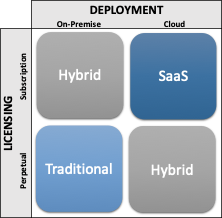 Strengthening your supply chain one link at a time.
Strengthening your supply chain one link at a time.
The Shift
When WMS vendors first introduced subscription licensing into the WMS marketplace, it was presented to prospective customers as an “also” option. This advanced relatively quickly to the “first” option vendors would propose. Recently, subscription licensing has evolved again, essentially becoming the “only” option many WMS suppliers are providing to prospective customers.
For a combination of reasons, the past year has been an extremely busy time frame for the WMS marketplace. Subsequently, WMS vendors are not only being selective as to what projects they will bid on, the vendors have begun to only quote subscription-based licensing for their WMS.
To be clear, there are several vendors which, from the ground up, have developed WMS solutions exclusively for cloud deployment and subscription-based licensing. The recently detected shift has been by the vendors who have routinely implemented their WMS solution through both licensing models.

The matrix above summarizes the combinations of deployment and licensing options. Traditionally, WMS has been deployed on-premise with a one-time perpetual license fee. Whereas a subscription-based license deployed in the cloud is also referred to as SaaS (Software as a Service). Hybrid combinations of deployment and licensing can also be considered.
The Cause
Regardless of public or private ownership, WMS vendors appear to prefer the more stable and predictable revenue stream generated by subscription-based software licensing. While perpetual licensing typically generates ongoing fees for software maintenance and support plans, the perpetual licensing is largely a front-loaded cash flow model.
The lowering of several technology barriers was a prerequisite to the recent shift to subscription-only licensing. Relative to other supply chain execution systems (e.g., Distributed Order Management, Transportation Management, Slotting, Labor Management, etc.), WMS has been a laggard in moving to the cloud due to system response time and data security issues. The advent of high-availability, low-latency cloud services and security protocols and standards have collectively lowered these concerns. Additionally, cloud architectures (applying to both private and multi-tenant platforms) now better support extensibility of new or customized functionality.
The Consequence
The current Hobson’s Choice may ultimately save us from ourselves. We often evaluate licensing models through a financial lens (capital vs operating expense, cash flow impact, total cost of ownership calculations, return on investment comparisons, break-even analysis, etc.). When evaluating over a broad time horizon (5 to 10 or more years) if the eventual upgrade costs are not adequately considered, the perpetual license will appear to be lower cost. Once implemented, customers with a perpetual license often find themselves painted into the proverbial corner – increasingly exposing their business to both technical and functional obsolescence.
Beyond protecting against obsolescence, subscription licensing and cloud deployment can provide a viable WMS option to customers who previously found the up-front costs of the traditional model to be too high. This, of course, depends in large part on the suppliers’ ultimate go-to-market strategy.
More predictable and stable revenue is not only good for WMS vendors, it indirectly benefits the vendor’s customers – helping to ensure their longevity in the WMS marketplace. The subscription model can foster a more collaborative relationship between a vendor and their customers than compared to the annual support contracts, which tend to trigger a more adversarial attitude.
—Kail Plankey, St. Onge Company